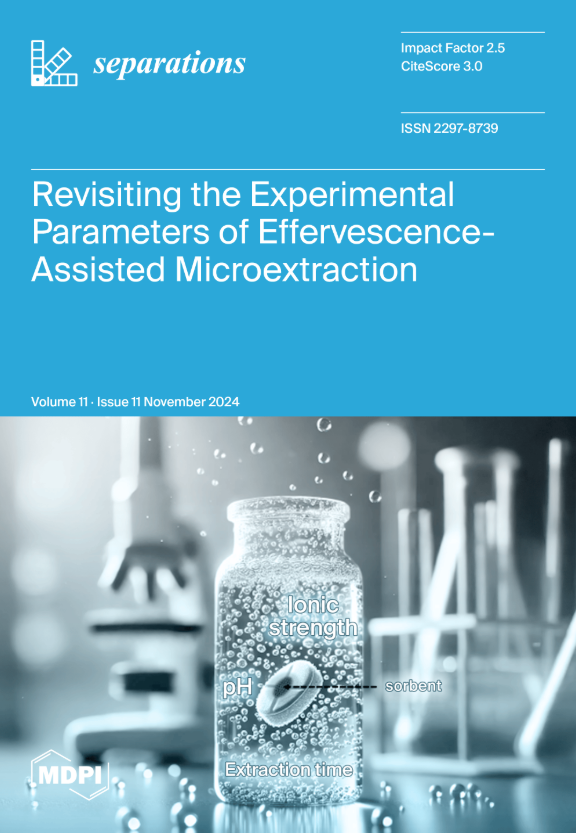Treatment of Produced Water Using Prepared Activated Carbon-Based Sewage Sludge
IF 2.7
4区 工程技术
Q3 CHEMISTRY, ANALYTICAL
引用次数: 0
Abstract
Removal of organic pollutants and metal ions from produced water by adsorption, using prepared activated carbon (AC) from sewage sludge, with chemical activations using NaOH, KOH and ZnCl2 separately and pyrolysis at different temperatures (500, 600 and 700 °C). Pure sludge and prepared ACs were analyzed using FTIR and XRD. The results showed 18% crystallinity compared to that of commercial AC, which has 44% crystallinity. The results of FTIR demonstrate that the properties of the post-treated affect the final products depending on the method used and that it contains similar functional groups to those present in the commercial AC, but at a higher peak intensity. Adsorption treatments were carried out at 25, 35 and 45 °C solution temperatures. The results showed that the removal of pollutants from produced water using prepared AC with all types of chemical activations reached 99.5%, such as commercial AC with 0.06 g dosage of adsorbent at pyrolysis temperatures of 500 and 600 °C and a solution temperature of 25 °C. The obtained results refer to the mechanism of exothermic reaction and physical adsorption. It was observed that despite the lower dosage of adsorbent of 0.01 g, a sufficient treatment of pollutants was achieved. This reveals the effectiveness of using sewage sludge as a cheap adsorbent. Also, using pure sewage sludge, the adsorption data showed a 95.2% removal of the pollutants. This result indicated that pure sludge has an efficient adsorption capacity and can be utilized as a cheap and environmentally friendly material. For the removal of manganese and cadmium metal ions from the produced water, the resultant data showed that more than 90% of manganese was adsorbed and more than 97% of cadmium was adsorbed, especially when using pure sewage sludge and prepared activated carbon with NaOH chemical activation at pyrolysis temperatures of 500 °C and 600 °C.活性炭基污泥处理采出水的研究
利用污泥制备的活性炭(AC),分别用NaOH、KOH和ZnCl2进行化学活化,并在不同温度(500、600和700℃)下热解,吸附去除产水中的有机污染物和金属离子。采用红外光谱(FTIR)和x射线衍射(XRD)对纯污泥和制备的活性炭进行了分析。其结晶度为18%,而商用AC的结晶度为44%。FTIR的结果表明,根据使用的方法,后处理产物的性质会影响最终产物,并且它含有与商用AC中存在的官能团相似的官能团,但峰值强度更高。在25、35和45℃的溶液温度下进行吸附处理。结果表明,在热解温度为500℃和600℃,溶液温度为25℃的条件下,以0.06 g吸附剂添加量制备的各种化学活化的活性炭对采出水中污染物的去除率达到99.5%。所得结果与放热反应和物理吸附机理有关。结果表明,尽管吸附剂用量较低,为0.01 g,但对污染物的处理效果较好。这揭示了利用污水污泥作为廉价吸附剂的有效性。对纯污泥的吸附数据表明,污染物的去除率为95.2%。结果表明,纯污泥具有高效的吸附能力,可以作为一种廉价、环保的材料加以利用。对于采出水中锰和镉金属离子的去除,结果数据表明,在500℃和600℃热解温度下,使用纯污水污泥和NaOH化学活化制备活性炭时,锰的吸附率达到90%以上,镉的吸附率达到97%以上。
本文章由计算机程序翻译,如有差异,请以英文原文为准。
求助全文
约1分钟内获得全文
求助全文
来源期刊

Separations
Chemistry-Analytical Chemistry
CiteScore
3.00
自引率
15.40%
发文量
342
审稿时长
12 weeks
期刊介绍:
Separations (formerly Chromatography, ISSN 2227-9075, CODEN: CHROBV) provides an advanced forum for separation and purification science and technology in all areas of chemical, biological and physical science. It publishes reviews, regular research papers and communications. Our aim is to encourage scientists to publish their experimental and theoretical results in as much detail as possible. There is no restriction on the length of the papers. The full experimental details must be provided so that the results can be reproduced. There are, in addition, unique features of this journal:
Manuscripts regarding research proposals and research ideas will be particularly welcomed.
Electronic files and software regarding the full details of the calculation and experimental procedure, if unable to be published in a normal way, can be deposited as supplementary material.
Manuscripts concerning summaries and surveys on research cooperation and projects (that are funded by national governments) to give information for a broad field of users.
The scope of the journal includes but is not limited to:
Theory and methodology (theory of separation methods, sample preparation, instrumental and column developments, new separation methodologies, etc.)
Equipment and techniques, novel hyphenated analytical solutions (significantly extended by their combination with spectroscopic methods and in particular, mass spectrometry)
Novel analysis approaches and applications to solve analytical challenges which utilize chromatographic separations as a key step in the overall solution
Computational modelling of separations for the purpose of fundamental understanding and/or chromatographic optimization
 求助内容:
求助内容: 应助结果提醒方式:
应助结果提醒方式:


